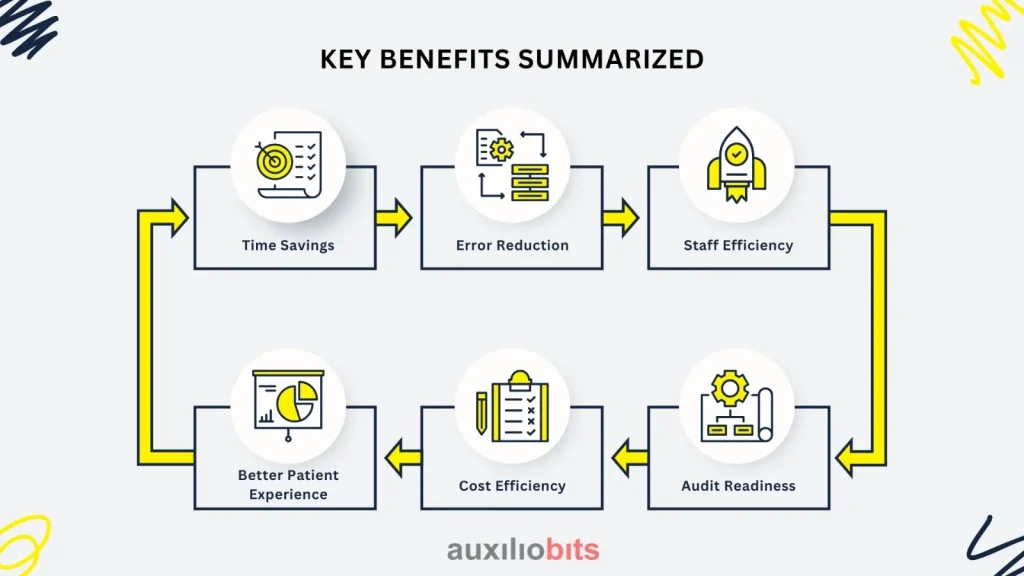
Key Takeaways
- RPA complements, not replaces, your EHR — automating repetitive tasks while preserving your current system investments.
- Impactful use cases include eligibility checks, claims processing, appointment management, and document handling.
- RPA boosts productivity and morale, freeing staff from heavy admin work so they can focus more on more important tasks.
- Implementation is minimally disruptive—bots can mimic human actions within your existing environment, with no major IT overhaul.
- Security and compliance are achievable when RPA is implemented with HIPAA-aligned protocols.
If you work in healthcare, then one moment you’re with a patient, and the next, you’re knee-deep in scheduling issues, insurance follow-ups, and documentation. These tasks are necessary, but they can drain time and energy from where it counts: delivering care. That is precisely why automation has become more than just a nice-to-have.
That is where Robotic Process Automation comes in.
EHRs like ModMed and eClinicalWorks have helped digitize healthcare workflows, but they don’t take all the manual work off your plate. People are still stuck doing the same routine work—typing in data, sorting out billing, and chasing follow-ups.
This blog delves into how RPA can help streamline these workflows, reduce human error, and make life easier for both clinical and administrative staff. Whether you run a small clinic or manage operations at a large multi-specialty group, this guide is for you.
Also read: Synthetic Data Generation for Healthcare AI Training: Techniques and Privacy Considerations
What Exactly Is RPA — and Why Should Healthcare Care?
RPA, or Robotic Process Automation, is software that mimics human actions on a computer. It doesn’t replace your EHR or management systems—it works with them. Think of it as a digital assistant handling tasks no one wants to do.
For example, if a staff member logs into eCW every morning to pull insurance eligibility reports, click through payer portals, and update patient records… An RPA bot can do that in minutes, without breaks or coffee.
It’s not AI, though it can work with AI. It’s rule-based and best for structured, repetitive work that follows a clear logic.
Why RPA Is a Game-Changer for Healthcare Admins?
Even with systems like ModMed or eClinicalWorks in place, day-to-day tasks still require a significant amount of manual effort. Teams often end up doing the same tasks over and over—entering data, dealing with billing, and chasing follow-ups. It’s time-consuming, and honestly, a bit draining.
To run things smoothly, you do not need to take on a massive change in your entire system. Often, it’s the small, repetitive tasks—clicking through screens, copy-pasting the same info—that wear teams down. That’s where automation, like RPA, can quietly step in. It works alongside your current tools, speeding things up and reducing those everyday errors.
Let’s take a look at how this could play out inside platforms like ModMed or eCW.
| User Access Management | Adding or removing users from ModMed? RPA bots can instantly and securely handle account creation, permission settings, and deactivation workflows. |
| Automated Appointment Management | Bots can read schedules, confirm appointments, send reminders, and automatically update calendars when changes occur. You’d be surprised how much time this saves your front desk. |
| Billing & Claims Processing | After a patient visit, bots can capture billing codes, validate them, generate claims, and even submit them to insurance portals — all without someone clicking through screens. |
| Pre-Visit Prep | Do you need forms completed, records retrieved, or insurance verified before the visit? Bots can prep everything and drop it into the patient’s chart before they walk through the door. |
| Data Migration Support | Are you migrating to or from ModMed? RPA bots can accurately and safely transfer structured data (such as patient history or lab results) from one system to another. |
What about eClinicalWorks (eCW)?
eCW is popular with general and family practices, and while it offers good functionality, a lot still needs a human touch… unless you bring in automation.
1. Revenue Cycle Workflows
From claim creation to denial management and payment posting, RPA bots can automate steps across the entire revenue cycle.
2. Eligibility Verification
Instead of logging into each payer’s site to check coverage, bots can bulk-verify insurance before appointments and push updates to patient records.
3. Smart Scheduling
Whether it’s new bookings, reminders, cancellations, or follow-ups, bots can automate these communications and reduce manual work dramatically.
4. Clinical Document Handling
Need to pull in lab results from PDFs or referral letters? Bots can read, parse, and populate fields in eCW based on incoming documents—even from scanned faxes.
5. Inventory & Prescription Monitoring
Some practices use RPA to monitor medication levels and trigger orders when stock is low. You can even automate prescription renewals based on doctor approval.
What Makes RPA Even Better?
You don’t need to rip out your EHR or build custom APIs. RPA works on top of what you already use.
Bots can:
- Log in to existing portals.
- Read and write data just like a human user.
- Navigate dropdowns, tables, and forms.
- Trigger actions based on specific rules
And because they operate within your existing systems, they’re easier to manage, update, and scale across teams.
But is it secure? (Yes, if done right.)
Healthcare data security is non-negotiable. RPA tools can be deployed in HIPAA-compliant environments and are designed with features such as encryption, role-based access, audit logs, and more.
You should also:
- Use a secure credentials storage solution (such as CyberArk or Vault).
- Restrict bot access to only the systems they need.
- Monitor bot activity with logs and alerts.
- Regularly review and update bot workflows.
- When implemented correctly, RPA enhances security by minimizing human error.
Key Benefits Summarized

| Benefits | Impact |
| Time Savings | 40–70% reduction in manual task time |
| Error Reduction | Up to a 90% drop in data entry issues |
| Staff Efficiency | Staff can focus on patient-facing work |
| Better Patient Experience | Faster, smoother check-ins & follow-ups |
| Cost Efficiency | Lower FTE costs for repetitive tasks |
| Audit Readiness | Automated logs of every action taken |
Things to Watch Out For
No solution is perfect. Some common pitfalls when deploying RPA in ModMed or eCW:
- Frequent UI changes in your EHR might “break” bots (good design minimizes this).
- Not involving staff early can create resistance.
- Trying to automate everything at once — it’s better to start small and scale.
So, how do you start? Here’s a simple roadmap:
- Pick 1–2 repetitive and time-consuming processes (e.g., eligibility checks or billing).
- Document the steps—what a human would do, click-by-click.
- Work with an RPA partner who understands healthcare (not just tech).
- Test in a non-production environment.
- Deploy gradually, monitor results, and iterate.
Looking Ahead: What’s Next for RPA in Healthcare?
The future is exciting. RPA is already merging with AI — creating Intelligent Automation that can:
- Learn from historical patterns.
- Prioritize high-risk claims.
- Summarize patient conversations.
- Assist in prior authorizations.
With technologies like OCR (optical character recognition) and NLP (natural language processing), RPA bots will get smarter and more context-aware.
It’s not just about automating—it’s about augmenting human teams so they can do their best work.
Final Takeaway
ModMed and eCW are powerful platforms. But on their own, they can still leave teams stuck doing repetitive work. Integrating RPA unlocks a new level of efficiency and precision.








